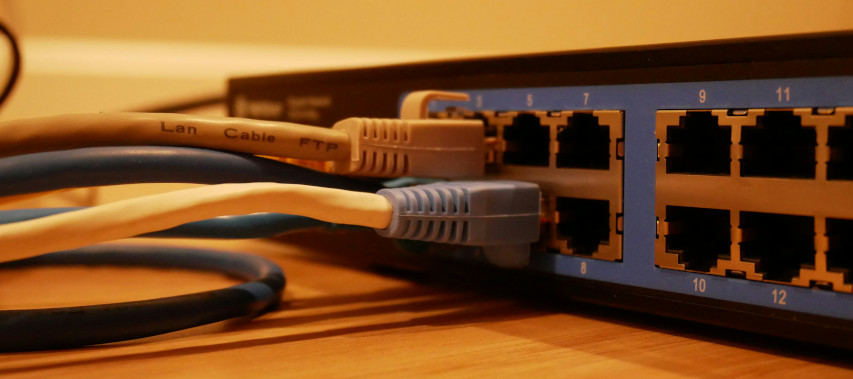
Networking & Structured Cabling System
Future Proof Investment: The most significant benefits of a structured cabling system is the high bandwidth, which makes it a reliable infrastructure for supporting business growth. Having adaptable IT that is scalable and can respond quickly to industry changes is vital. Supports quick and easy development and deployment of new services for enterprise network and data centers.
Simplicity: There is a high level of simplicity and straightforwardness that comes with an organized cabling system. In a typical office environment, several different devices and IT equipment are being used at the same time, so running everything off one single system eliminates the complexity of having multiple wiring infrastructures in place.
Cost Effective: Structured data cabling is a cost-effective solution for a smooth running business. Scalable and highly flexible network provides continuous flow of information and copes with the high demands placed on it. This in turn boosts productivity and drive business success.

Enhanced Flexibility: Structured cabling system provides an enhanced level of flexibility – helping to improve performance and drive business growth. It quickly and easily accommodate moves, adds and minor changes, which can reduce installation time and ensures optimum adaptability to any network infrastructure changes.
Reduced Risk of Downtime: A well-planned cabling system means easier troubleshooting, making it easier to identify and rectify faults quickly

Data Center
Data center facilities rarely achieve the operational and capacity requirements specified in their initial designs. The advent of new technologies that require substantial incremental power and cooling capacity; the pressure to consolidate multiple data centers into fewer locations; the need for incremental space; changes in operational procedures; and potential changes in safety and security regulations converge to impose constant facilities changes on the modern data center.
The overarching rule in data center facilities is to design for flexibility and scalability. This rule embraces several key principles in the site location, building selection, floor layout, electrical system design, mechanical design, and the concept of modularity that enables the data center facility to change and adapt as needed, with minimum renovation and change to basic building systems.

Ancillary Devices
Physical security is always a component of a wider security strategy, but it makes up a sizeable piece of this larger plan. Security experts agree that the three most important components of a physical security plan are access control, surveillance, and fire detection, which works together to make your space more secure.
Security is crucial to any office or facility, but understanding how to protect your business and its assets can be a process that seems nearly impossible at first. The best, most viable physical security strategies make use of both technology and specialized hardware to achieve its safety goals. You will need to protect your assets from intruders, internal threats, cyber attacks, accidents and disasters, which in turn requires a mix of technology and in-person monitoring that requires careful planning and placement of security staff and other schemes.

The specific security practices should be implemented to create a solid physical security strategy depending on the specifics of your premises and the nature of your business, but many physical security plans share certain core elements. Working examples of security strategy and countermeasures in physical security have a number of best practices in common.

Building Management System
In a nutshell, BMS-System otherwise called BAS or Building Automation is a computer-based control system which reduces workforce, automates the system, and add savings on energy consumption in buildings by monitoring and controlling the mechanical and electrical equipment in modern-day buildings or any industrial plants.
Nowadays, any modern-day buildings are built with BMS to support facilities management in accomplishing its maintenance and building energy saving plan from one place with the aid of Artificial Intelligence (AI). It has the power not only to automate buildings but also to make them truly adaptive, smart, and agile, with the use of AI analytics.
BMS are becoming more interactive and responsive to its occupants. As a result, building owners are increasingly interested in what transpires inside buildings at any given time, utilizing the knowledge and insights they obtain to improve building management, create better staffing plans, and reduce the operational costs of maintaining their business infrastructure in the hope of achieving better savings.

Managed Support Services
Technology plays a central role in business, making it a key component of almost every company. Staying on top of your business’s IT game can be a real challenge, as the technological environment is always changing. Overwhelmed with choices and a lack of expertise, many companies often overspend on IT without understanding which technology expenses are vital, a luxury or redundant.
Managed IT services consist of outsourcing the coordination of anything IT-related, from office hardware maintenance to network security needs and cloud storage and computing services. A few examples include outsourced helpdesk, outsourced CIOs, disaster recovery and back-up planning. If you’re not a very tech-savvy business, something as simple as forgetting to ensure all your antivirus software is up to date can risk an attack onset that could interrupt your business services and cause serious damage to internal security systems — as well as your company’s reputation. There is no one-size-fits-all when it comes to IT, as the needs of each enterprise can differ greatly.

Infrastructure Assessment
Important in understanding the product or services against the desired design during the scoping process of a project. The assessment provides the output of gap analysis in accordance to the designed model from the accepted product or services. This covers auditing the process, the technology, desired reports and recommendations in degree of meeting the desired output of the products and services.
The assessment includes best practice and compliance reporting aligned to industry standards. Z-Connect offers a systematic approach of infrastructure assessment. It provides gap analysis reports, best practices and alignment to industry standards. This includes vulnerability assessment for both physical and logical security of IT infrastructure. Security, automation, monitoring and notification process are critical part of predicting and identifying potential risks for an infrastructure.